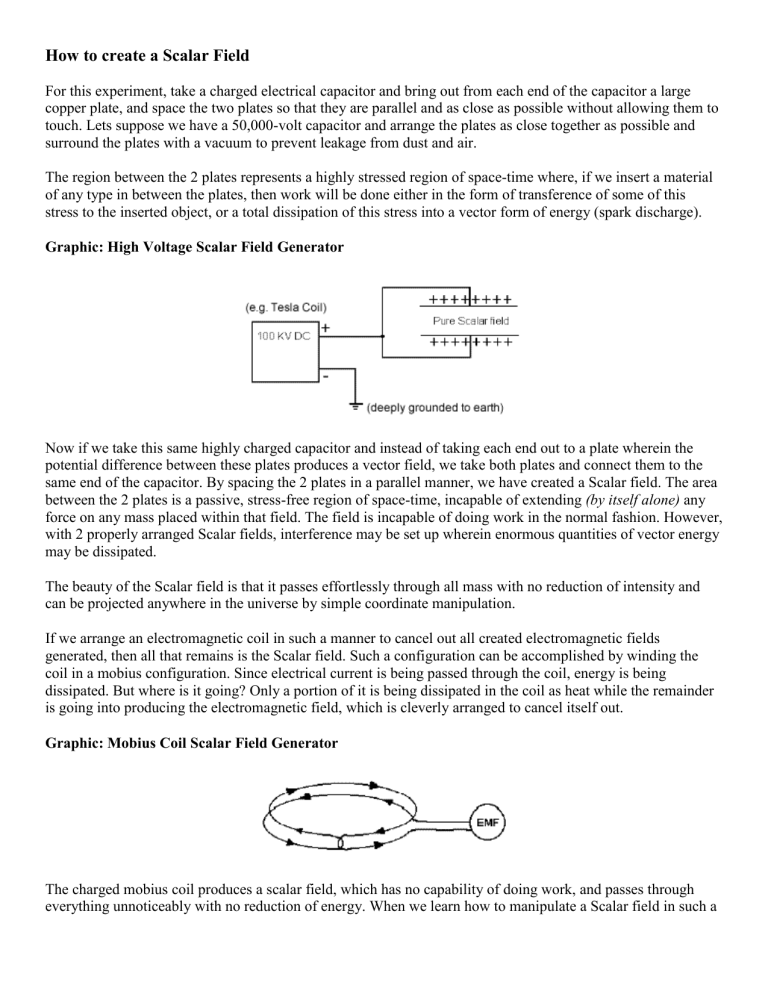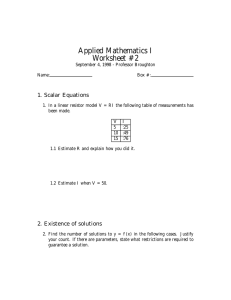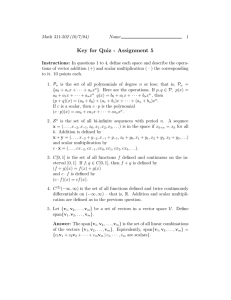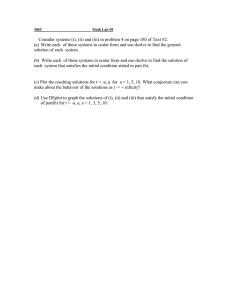
How to create a Scalar Field For this experiment, take a charged electrical capacitor and bring out from each end of the capacitor a large copper plate, and space the two plates so that they are parallel and as close as possible without allowing them to touch. Lets suppose we have a 50,000-volt capacitor and arrange the plates as close together as possible and surround the plates with a vacuum to prevent leakage from dust and air. The region between the 2 plates represents a highly stressed region of space-time where, if we insert a material of any type in between the plates, then work will be done either in the form of transference of some of this stress to the inserted object, or a total dissipation of this stress into a vector form of energy (spark discharge). Graphic: High Voltage Scalar Field Generator Now if we take this same highly charged capacitor and instead of taking each end out to a plate wherein the potential difference between these plates produces a vector field, we take both plates and connect them to the same end of the capacitor. By spacing the 2 plates in a parallel manner, we have created a Scalar field. The area between the 2 plates is a passive, stress-free region of space-time, incapable of extending (by itself alone) any force on any mass placed within that field. The field is incapable of doing work in the normal fashion. However, with 2 properly arranged Scalar fields, interference may be set up wherein enormous quantities of vector energy may be dissipated. The beauty of the Scalar field is that it passes effortlessly through all mass with no reduction of intensity and can be projected anywhere in the universe by simple coordinate manipulation. If we arrange an electromagnetic coil in such a manner to cancel out all created electromagnetic fields generated, then all that remains is the Scalar field. Such a configuration can be accomplished by winding the coil in a mobius configuration. Since electrical current is being passed through the coil, energy is being dissipated. But where is it going? Only a portion of it is being dissipated in the coil as heat while the remainder is going into producing the electromagnetic field, which is cleverly arranged to cancel itself out. Graphic: Mobius Coil Scalar Field Generator The charged mobius coil produces a scalar field, which has no capability of doing work, and passes through everything unnoticeably with no reduction of energy. When we learn how to manipulate a Scalar field in such a manner as to locate it anywhere we wish, we may project a second phase-shifted wave to the same coordinates to cause remote dissipation of virtually limitless quantities of energy. Hypothesis: Comparison between Scalar and Gravitational Fields Gravity appears to possess all the Scalar properties we have described; it passes effortlessly through all masses undiminished and is only recognized when a mass is placed in the proximity of another mass creating a gravity field vector which is capable of doing work and being recognized as "gravitational attraction." A gravity field vector can, hypothetically, be created by Scalar () Wave methods: By triangulating a series of 3 translator/projectors and using a resonant frequency (1012 cycles/second is the frequency of radiated gravity,) we can produce an interference wave front along 3 axes in such a way as to produce a levity effect, a pocket of space with its own gravitational field. In laymen's terms, we can produce antigravity, but this is a more advanced subject. What we're suggesting is the creation of an energy pocket or bottle: Using the proper resonant freqs. this pocket can take on the characteristics of its surroundings. For example, if we create the energy bottle in a low pressure, mass free region of our atmosphere with a potential for a hurricane, the energy bottle (hypothetically) becomes a hurricane. Since the energy bottle is directional, the hurricane (hypothetically) can be steered. Please look at Weather Control Warfare: Anomalous Energy Signatures for examples. example of scalar interferometry Hypothesis: Scalar () Wave Telemetry Technology The following is a brief overview of how to make an Omnidirectional longitudinal Scalar () Wave Receiver & Transmitter. In contrast to common (Hertzian) transverse vector waves, Scalar () Waves materialize at the receiving end, at superluminal velocities. Scalar () Waves also quite effectively penetrate through EM barriers, such as a Faraday Shield, which would stop an ordinary electromagnetic (Hertzian type) wave. Shown below is a simple directional, Scalar () wave generator/detector. How to Build Caduceus or "Tensor" Coils for Scalar Wave Telemetry caduceus coil scalar field generator Ordinary insulated copper wire is wound in a double helix configuration around a ferrite core. This coil has a canceling effect of the magnetic fields at the nodes, due to the opposing magnetic fields summing to zero. The nodes MUST lie along a straight line. Once the magnetic field is cancelled, you are left with a field of pure potential. This field will be a narrow threadlike beam parallel to the cylindrical axis. By precise physical alignment of two Caduceus coils, one as transmitter and the other as a receiver, you can send signals that can't be detected on a standard Hertzian type radio receiver. This receiver/transmitter combination is limited to "line-of-sight," i.e., beyond the curvature of the planet, transmitter and receiver must be aimed through the planet. Potentially, this system can transmit and receive a signal anywhere within, on, and beyond the planet: example of scalar wave telemetry Application of Pulse-Frequency-(De)Modulation to Scalar Wave Telemetry See Popular Electronics August 1980, PG 94 & 95, for a simple PFM Modulator/Demodulator. For an inexpensive, user friendly PFM, put together your own Electronic Pulse Generator Kit from this merchant. Tune the carrier frequency so that it falls in the "Experimenters band" of 160 to 180 kilocycles. Note: By definition Hertzian type waves are transverse vector waves. So the units used when referring to Scalar () waves should be given in the old form of Cycles-Per-Second (Kilocycles, KC or Mega-Cycles, MC), to prevent confusion. Measure the impedance, and inductance, of the Caduceus coil, and find their natural resonant frequencies using the PFM between two coils. How to Produce Scalar Fields using Simple Materials Obtain two Radio Shack (rectangular) ceramic magnets and glue their north pole faces together. Wind the magnets with about 50 turns of #30 magnet wire. Wire gauge is not critical. The brush noise from the DC motor provides a pulse signal to the coil, which modulates the 'colliding' field pattern of the magnets and creates interesting Scalar effects within a narrow pencil-beam pattern, which extends from each face of the magnet out to a few inches. This particular effect extends and exploits a characteristic of permanent magnets which is not covered in conventional physics. Scalar effect extends Bloch Walls of permanent magnets What is the nature of anti-gravity in a magnet? What is a Bloch Wall? A Bloch Wall is the point of division of the circling vortex, or spin, of the electron magnetic energies of the north and south poles. The north pole (-) magnetism spins to the left; the south pole (+) magnetism spins to the right. The point of zero magnetism and no-spin, which is also the point of magnetic reversal where the two spin fields join, is the Bloch Wall. Bloch Wall Illustrated in a Magnet We have two antithetical polarities meeting and generating a third element, the Bloch Wall, which is a weak pressure (gravity) generator. The south pole is the source and the north pole is the sink. The individual pole energy rotations are three component vectors and the conjunction (Bloch Wall) is a tensor. The 'Broken 8' wave zone in the Bloch Wall - Notice the similarity between the lines of force and wrapping a caduceus coil In all electromagnets, the Bloch Wall is actually external to the unit. The Bloch Wall, the neutral center gravity wave source, is also generated just outside the gap between the north magnet faces when power is applied. Bloch Wall as Independent of the Magnetic Fields In terms of the electromagnetic spectrum, the point of 1012 cycles/second is marked as our non-Hertzian gravity, while below this is Hertzian components of radar, radio, and standard EM frequencies. Above it are infrared and optical energy frequencies. 1012 cycles/second is the frequency of radiated gravity. Bloch Wall/Gravity Wave Field Source as a function of the Electromagnetic Spectrum A Bloch Wall is a gravity wave field source and is a function of the electromagnetic spectrum as illustrated. A Bloch Wall is a neutral central region at the junction of two magnetic poles; as a dipolar, permanent magnet, this includes the Earth, the other planets and similar celestial bodies. Bloch walls are "magnetic flow reversal points" also known as a "diamagnetic vortex points." These "points" can be seen on the grid system maps at Ley Lines, Cancer, and Earth Grid. The actual lines of magnetic force on the earth due to the Bloch Wall Suggested Scalar Wave Experiments using a Bloch Wall Purchase two identical music CDs. Listen to both to verify that they are identical. Now let the "Scalar () beam" play all over the surface of one of the CDs for about one minute. You may want to build a simple rotating platform to make this process more convenient. Now play the two CDs and compare them again. Hear any difference? Connect a small probe-coil to an oscilloscope, then move it around in the beam and observe the waveforms. Taste some wine, then put it in a small airtight container and place it against the magnet face for a few (minutes? hours?) Taste it again. Improvements? Try it with and without the power supply connected to verify that any changes are caused by the Scalar () beam and by just the magnetic field. Place various types of food in the beam then compare flavor with untreated samples. Grow two collections of plants, water one with normal H2O, water the other with H2O that's been treated by several minutes. Then try Hours of exposure to the beam. Aim the beam directly at a plant for many days, compare it with another untreated plant as a control. Sprout two groups of seeds, one treated and one untreated, and look for differences in number, health, growth rate, etc., between the two groups. Measure the growth of the tip of a plant stem by using a tiny lever, mirror, and laser beam. Graph the growth rate, then treat the plant with the Scalar () beam and look for changes in the rate. (Note that this method can also be used to observe plants' realtime response to numerous stimuli both conventional and "weird." Fertilizer? Light? Music? Good / Bad thoughts?) Observe microscopic life forms in pond water, then expose them to the beam. See if their behavior changes while it is operating. Or, expose the water to the beam for several minutes or hours, then compare the number and activity of life forms in the water with an untreated bottle. Compare the effects of adding the same treated or untreated pond water to a slide under the microscope. Use an op-amp buffer and an audio amplifier to listen to the noise output of a capacitor which is shielded in a thick copper box, (or does a resistor or transistor work better?) then aim the beam at the box and listen for signals. Experimental Objective: Prove the Efficiency of Scalar () vs. Transverse EM Wave Electrical Power Transmission The following notes were taken from an experiment by Eric P. Dollard on the power transmission efficiency of longitudinal magneto dielectric (scalar) waves versus transverse waves. Between the two systems, he uses the same components; all he does is switch them around to derive scalar vs. transverse. First, let's examine a transverse wave set up: Transverse Wave Test Setup Each element in this set up has capacitors parallel and inductors perpendicular to source. As you see, the components in this test consist of: 1. 2. 3. 4. Frequency Oscillator Operational Amplifier Inductors with power rating to match the op-amp Capacitors with power rating to match the op-amp The test equipment consists of a magnetic and electric probes. The capacitors can be electrolytic, but this is not required. When using electrolytic, make sure polarities are aligned with each other. The number of components/elements are set up at one quarter wavelength. Using the transverse wave set up, the following data was uncovered: 1. 2. 3. 4. The magnetism is greater towards the source The dielectricity is greater towards the load The heat of the inductors is greater towards the source The heat of the capacitors is greaters towards the load The result of a transverse EMW power transmission: The magnetic energy is greater towards the source while the dielectric energy is greater towards the load. The resonant frequency for power transmission was 1520Hz (1.52KHz). Now, let's examine a scalar wave set up using the same components: Scalar () Wave Setup In the scalar wave setup, the apparatus has capacitors perpendicular and inductors parallel to the source. The following data was uncovered: 1. 2. 3. 4. The magnetic energy is greater towards the load The dielectric energy is also greater towards the load The heat of the inductors is greater towards the load The heat of the capacitors is greater towards the source The result of a scalar () wave power transmission: Both magnetic and dielectric energies are greater towards the load. The resonant frequency for power transmission was 3600KHz (3.6MHz). Conclusion: A. In the transverse wave setup, magnetic and dielectric energies are in space opposition to the apparatus. This indicates an unnatural electric form. B. In the scalar () wave setup, magnetic and dielectric energies are in space conjunction to the apparatus. This indicates a natural electric form. Tesla Scalar Wave Systems: The Earth as a Capacitor by Richard L. Clark Tesla Scalar Wave Systems: The Earth as a Capacitor Nikola Tesla engineered his communications and power broadcast systems based on the Earth as a spherical capacitor plate with the ionosphere as the other plate. The frequencies that work best with this system are 12 Hz and its harmonics and the "storm" frequency at around 500KHz. The basic Earth Electrostatic System and the basic Tesla Designs are shown in the figure above. The circuit apparatus must be one quarter wavelength or some odd multiple of it. The elevated capacitor has two functions: Capacity to ground (Cg) and Capacity to Ionosphere (Ci). The bottom plate only to ground is Cg. Both plates are Ci. L2 and C3 are a resonant stepdown air core coupling system at the desired frequency. Simple calculations allow resonant frequency values to be determined from the Tesla Equivalent Circuit diagram. Be extremely careful of high voltages in this system (reactance chart not enclosed). Scalar () Wave Detector Configuration This configuration of Faraday Cage, oscilloscope, resonant tuning circuit, pre-amp and magnet, and necessary cabling is capable of detecting Scalar () waves and fields: Scalar () Wave Detector






